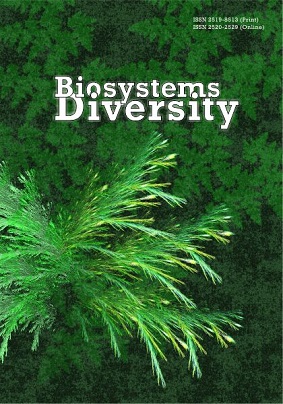Morphological variation of Varroa destructor (Parasitiformes, Varroidae) in different seasons
Morphological variation of Varroa destructor (Parasitiformes, Varroidae) in different seasons
Author(s): V. O. Yevstafieva, L. M. Zaloznaya, O. S. Nazarenko, V. V. Melnychuk, A. G. SoboltaSubject(s): Agriculture, Sociobiology, Environmental interactions
Published by: Дніпропетровський національний університет імені Олеся Гончара
Keywords: varroosis; Apis mellifera; female mites; morphotype; seasonal adaptation;
Summary/Abstract: Varroosis is one of the most dangerous and common diseases of honey bees (Apis mellifera Linnaeus, 1758) worldwide, caused by gamasid mites of the species Varroa destructor Anderson and Trueman, 2000. This external parasite is widespread and adapted to the climate conditions of most countries of the world, and it can infect bees at any life stage. It parasites on worker bees, male and queen bees, larvae and pupae, feeding on their hemolymph and fat bodies, causing lower survival rates and lower density of bee colonies, decreasing the bees’ life span. Here, we studied the specifics of the seasonal variation of female V. destructor mites, obtained from honey bees, by the morphological characters of mites belonging to the summer and winter generations, and their differences were established. Using the methods of multivariate statistics, we found significant differences between the summer (June–July) and winter (October–November) morphotypes of V. destructor mites. There are differences between the seasonal samples by 12 morphological characters of the parasite, namely the width of dorsal shield, width of dorsoventral shield, number of pores on sternal shield, length of tarsus and macrochaeta IV, and distances between setae of gnathosoma. Processing the seasonal samples of mites with discriminant analysis resulted in differences by 11 morphological characters including the length of dorsal shield, number of lancet setae, length and width of genitoventral shield, width of anal shield, number of setae and pores on sternal shield and distance between setae of gnathosoma. In general, the summer females are smaller and elongated compared to winter females, with larger genitoventral shield and shorter legs. The mites of summer and winter generations are adapted to different seasons: the summer mites to the reproductive period, the winter generation to overwintering on bees. The ratio of morphotypes in female V. destructor mites is observed to change during the year, from 20.2% winter morphotype in summer generation to 20.7% summer morphotype in winter mites. Studying the influence of acaricides on the distinguished morphotypes is a promising approach to improve pest control measures against varroosis of honey bees.
Journal: Biosystems Diversity
- Issue Year: 28/2020
- Issue No: 1
- Page Range: 18-23
- Page Count: 6
- Language: English

